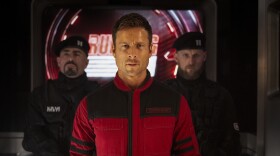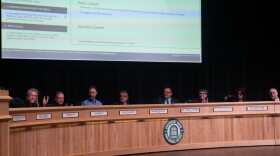For more, watch our video: Secrets From The Recycling Plant
The rise of curbside recycling programs over the past few decades has meant more glass recycling. But for a long time, many recycling centers didn't have the technology to turn recycled glass into the raw material for new bottles. Instead, recycled glass often wound up being used as a cheap construction material, or even to cover landfills.
Now, with new technology that can better sort glass collected in curbside recycling, more used glass bottles can be turned back into new glass bottles. To see how this works, we went to a glass recycling facility and a bottle factory.
Outside a recycling plant in Jersey City, N.J., there are piles and piles of what looks like garbage.
But it's actually broken glass, mixed with things like plastic bags, bottle caps, etc. Large items like some cans and plastic jugs have already been sorted out.
Inside the plant, the stuff goes through more sorting. To isolate the glass, a magnet first pulls out metal caps, lids, small tin cans, and other pieces of metal.
Getting the metal out is the easy part. But to turn glass back into bottles, you also have to sort the broken glass by color. (Clear glass is the easiest to turn back into bottles, and the most valuable product of glass recycling.)
When recycling centers relied mainly on human labor, sorting out broken pieces of clear glass from the greens, browns and blues was a slow and dangerous job, says Tom Outerbridge, the general manager at the recycling facility.
Today, recycling plants use optical sorting machines. These machines take pictures of all the glass, and then use air jets to blow the clear glass onto a different conveyor belt.
The recycling plant sells the crushed clear glass to bottle manufacturers, like Ardagh Group in Salem, N.J. When we visited, they were making Snapple bottles, Mason jars and Nantucket Nectar bottles. Gary Shears, the general manager, says that they use about 150 tons of clear recycled glass a day.
Here's a front-end loader delivering 25 tons of recycled glass to the bottle factory:
The recycled glass is mixed with soda ash, sand and limestone, and everything is melted together in a furnace heated to 2,700 degrees. (We wanted to take a picture of the furnace, but they warned us that it was so hot that getting close to it could destroy our camera lens. Which makes sense, given that it was hot enough to melt glass.)
Shears says they can never get enough recycled glass. Recycled glass melts at a lower temperature than the raw materials used to make glass from scratch. So more recycled glass means huge energy savings. Right now, his bottles are made of about 20-25 percent recycled glass. Shears said he would use two or three times as much, if there was more recycled glass available.
The bright orange molten glass is weighed and cut into pieces called gobs, which are dropped onto molds to create the mouth of the bottles.
Then a glass-blowing machine blows the gobs of molten glass into red-hot bottles. Salem's newer machines can make about 400 bottles a minute.
The Salem glass factory ships about 3 million Snapple bottles a day, six days a week.
* Note: A previous version referred to a bulldozer delivering recycled glass to the bottle manufacturer. It is actually a front-end loader.
Copyright 2023 NPR. To see more, visit https://www.npr.org. 9(MDAzMjM2NDYzMDEyMzc1Njk5NjAxNzY3OQ001))






